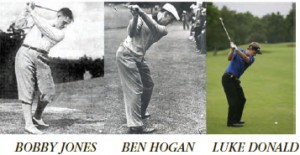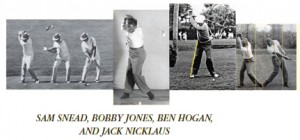Modern vs Old – Teaching Golf Full Circle
Below are pictures of various great players from the past and present, all of whom (except Jack Nicklaus and Sam Snead) perform the backswing in a fl atter-type position, aka Jim Hardy’s “One Plane Swing.” There are obvious differences in each swing. However, I believe the goal as an instructor is to point out the common denominators found within the swing motions of all great players. A few photos are accompanied by reference lines to make it easier.
DOWN THE LINE

Up to now, I’ve discussed in-depth the evolution of golf technique, or actually, golf instruction. Has swing technique really changed, or do we simply have a better understanding of it today? I’m leaning toward the latter. For years, achieving a reliable and repeatable golf swing has been considered almost impossible, even for the most gifted players. More has been written about the technique of the golf swing than the technique of all other sports combined. Think about that. The reliable golf swing is an entity unto its own, one that has been looked upon as so perplexing and unattainable that it has achieved a mystical-like notoriety.
Hopefully, our modern-day knowledge, with the ability to properly interpret some of the great players’ (past and present) thoughts about the golf swing, has solved the mystery. It certainly appears so, as we witness the plethora of young and experienced players of today repeatedly put up impressive results practically every time they tee it up.
From the photos above (except Nicklaus), we see one thing in common. The lead (left) arm is parallel or very close to parallel to the shoulder plane at the top of the backswing. Often considered in golf terms as a fl at swing, today it is considered to be a “one plane swing,” again a term coined by Hardy. What is interesting in further understanding this fl atter lead arm position is that it all makes sense today when we think about the term “swing inside a barrel,” as originally popularized by Slammin’ Sammy Snead. Check out the photos below:
FACE ON
Here are four great players providing examples of swinging inside the barrel. “Swinging inside the barrel” is making sure there is no lateral hip sway away from the target during the backswing. Although Snead and Nicklaus both turn inside the barrel, they do so by completing the turn with more weight on the back foot. This is easily witnessed by the fact their right knee is practically over the right foot, whereas it is inside the right foot with Jones and Hogan.
The photos from the down-the-line view show Jones and Hogan with a flatter lead arm position. Nicklaus and Snead had a more upright lead arm position (two planes) at the top of the backswing. These are two distinct styles of swings. One (the flatter, one plane swing) is a more rotational type swing. The more upright motion also incorporates more lateral motion, especially during the downswing. Why is all of this important, how does it relate to how we teach today, and is what we teach today really different from yesteryear?
As an instructor, you should be able to recognize whether a student has an easier time striking the ball while swinging the club in a more upright or fl atter fashion. This is simply a preference and does not negate the fact that turning inside the barrel is one of the key components to a repeatable and reliable golf swing. It allows the golfer to create power through rotation, but more importantly, it offers a better chance to post up on their front foot while striking the ball. Also, the upright or fl atter motions don’t take away the fact that the downswing swing is initiated from the ground up.
The upright motion’s downswing is initiated with a more lateral based motion toward the target with the lead knee and pelvis (hips), allowing for a fl attening of the downswing plane. Hence, the need to have more weight on the back foot while turning inside the barrel. Since the fl atter motion is more rotational with less weight on the back foot while turning inside the barrel, the initiation phase of the downswing is less lateral in nature. It is initiated with more rotation of the hips. This does not mean there is no lateral motion at all, just less, and it often occurs more naturally due to leverage to the ground with both feet at the top of the backswing.
Bottom line, the swing motion must be performed in sequence (see past sequence of motion article) in order to strike the ball solidly. Secondly, the rotational aspects of the core area of the anatomy/hips (turning inside the barrel) are non-negotiable for creating power and making the sequence easier to perform. These two crucial elements of the swing have not changed throughout the eras, but are seldom given enough credence in modern teaching today. There are two distinct styles of golf swings. They are both effective and one is not ideal over the other or suited for every player. This, of course, brings us back to how we as teachers must know what are the true common denominators in the golf swing that have not evolved with time.






